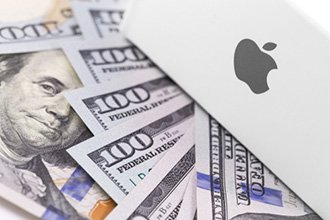Apple stock is up about 65% in 2019 and 125% over the past five years. It's trading at about $260 a share and continues to make all-time highs.
And yet now is the time to buy Apple stock.
It seems counterintuitive. When a stock has made the kind of gains that Apple Inc. (NASDAQ: AAPL) has, conventional wisdom says if you own it you cash out. And if you don't own it, don't buy at the top.
 But Apple has never been a stock that conforms to conventional wisdom. It has "peaked" numerous times.
But Apple has never been a stock that conforms to conventional wisdom. It has "peaked" numerous times.
For instance, after the AAPL stock price hit a split-adjusted $100 a share in September 2012, many pundits soured on the company. The next year, the stock fell more than 40%, and Wall Street viewed it as "dead money."
By late 2014, Apple was back over $100 and on its way to new highs. And it's more than doubled since then.
Right now sentiment on the company is high and analysts are jacking up their Apple stock price targets. The top target is set at $300.
But as usual, Wall Street is a bit behind. Even a target of $300 is well short of where Apple shares are headed within the next two years.
"Apple is making a fundamental pivot into services and, specifically, into the single most lucrative market in the world... healthcare," said Money Morning Chief Investment Strategist Keith Fitz-Gerald. "The U.S. medical market alone for Apple-powered medical devices may be three times the entire global iPhone market. That pencils out to around $300 billion, in case you're wondering, all of which is a far higher margin."
Fitz-Gerald currently has an aggressive AAPL stock price target of $400 by mid-2021. That represents a 54% gain from the current price.
That's a pretty good reason to buy Apple stock.
And it's all here in the numbers...
How Healthcare Drives Apple Stock to $400
Earlier this year, Morgan Stanley (NYSE: MS) did a deep dive on Apple's healthcare opportunity. And the results were staggering.
The investment bank concluded that healthcare could add anywhere from $15 billion to $313 billion annually to Apple's top line. The report pegged the midpoint at $90 billion of additional revenue by 2027.
Revenue for Apple's 2019 fiscal year (which ended Sept. 30) was $260.17 billion. So if the Morgan Stanley report is right, that represents a revenue increase of nearly 35%.
If you convert that to earnings per share, you end up with roughly an additional $4.44, which would put Apple's 2027 EPS at about $16.33. Given a price/earnings (P/E) ratio of 22 (AAPL's current P/E), you end up with a stock price of about $360 per share.
But Morgan Stanley's midline of $90 billion of additional revenue isn't in the middle of its range. The mathematical midpoint is actually $164 billion of additional revenue. If you round that down to $150 billion, you end up with an additional $7.33 in earnings.
That would put Apple's 2027 EPS at $19.22 and its share price at $422 - comfortably over our target price. The price can even get there by 2021 if Wall Street wakes up to what's happening.
The approximate revenue required just to get AAPL to $400 is $120.68 billion. Given the range in the Morgan Stanley report, that's not particularly outlandish.
I admit this all sounds a bit abstract. So let's get more concrete...
How Apple Will Monetize Healthcare
We've already seen some of the ways Apple plans to profit from healthcare, and it has more in the pipeline:
- Apple Watch: The Watch is Apple's primary healthcare product for now. It can monitor workout progress and take a basic EKG. The Watch will continue to figure prominently in Apple's healthcare strategy. This product is already making an impact. In Apple's most recent quarter, revenue from its wearables segment (which includes the Watch, Beats headphones, and AirPods) was up 54% from the same quarter a year ago. It's approaching the revenue levels of Apple's venerable Mac segment. What could kick the Watch to another level revenue-wise is if health insurance companies start to classify it as a medical device they cover. Several insurers started moving in that direction last year.
- iPhone: Although not as health-focused as the Watch, Apple has been steadily adding health functions to the iPhone. The built-in sensors can be harnessed to monitor a user's environment during health emergencies such as an epileptic seizure. The iPhone can also pull together the user's health data. And Apple is said to be adding more health-monitoring features to the iPhone. Plus, third parties have started to build devices designed to work with the iPhone. These new "medical missions" for the iPhone will eventually lead to some iPhones being purchased primarily as health devices, fortifying overall sales.
- AirPods: These popular accessories may someday do more than play music and podcasts. Apple has filed patents that would add the ability to capture biometric data from the wearer, such as heart rate, body temperature, and oxygen consumption. Apple could also create additional medical wearables in the future.
- AR/VR Devices: Apple is thought to be working on both augmented reality glasses (expected in 2023) as well as a headset that would be a hybrid of both AR and virtual reality (expected in 2022). Both could have medical applications.
- Health Records: In 2016, Apple bought a startup called Gliimpse, a personal health data platform. Because of its vertical integration of hardware, software, and the cloud, Apple can collect, store, and transmit patient data without the patient having to input that data manually. Apple is creating a health data ecosystem that ultimately will benefit both the patient and healthcare provider. Apple is also a partner in a health data standard called FHIR (Fast Healthcare Interoperability Resources) that will allow it to monetize health data management. From the Morgan Stanley report: "If Apple becomes the patient record registry, they are in essence of becoming a national HIE [health information exchange]. Hospitals no longer have to pay for multiple HIE systems at a local level, but could instead directly pay a single data aggregator for access to patient records across the country. We see value in leveraging Apple's central repository across each healthcare vertical - which can create significant fee generating opportunities over time."
And don't underestimate Apple's advantage in having decades of experience building ecosystems.
Because Apple makes the hardware and software in addition to running the services it offers, all the pieces work together seamlessly. The one-vendor approach avoids the kinds of glitches that plague systems cobbled together from products by multiple vendors. Plus, the tight integration helps Apple keep user data secure.
All that translates very nicely to healthcare. Medical systems need to work. And patient data must be protected by law.
To be sure, Apple will have competition from other Big Tech companies. Microsoft Corp. (NASDAQ: MSFT), Amazon.com Inc. (NASDAQ: AMZN), and Alphabet Inc. (NASDAQ: GOOGL) are all known to have healthcare projects in the works.
But Apple's skills at vertical integration and emphasis on privacy will give it an edge.
Still, things could go wrong. But healthcare won't be alone in adding revenue to Apple's top line...
AAPL Stock Has More Than One Path to $400
[mmpazkzone name="in-story" network="9794" site="307044" id="137008" type="4"]
A boost from healthcare would drive Apple's hardware sales - particularly the Watch and the iPhone - much higher than current Wall Street estimates.
But even without it, Apple will continue to see at least stable hardware sales. And that's all it will need to realize gains from another major profit center.
Here's how it will work.
Even now, Apple's hardware sales continue to expand the installed base of Apple users. In Apple's most recent quarter, the company said half the customers who bought a Mac were new to the platform. One-quarter of those who bought an iPad were new to the iPad.
The installed base matters because all those users - approximately 1 billion people own at least one Apple device - are also signing up for Apple's services. And that's where most of its revenue growth is coming from now.
Apple services include Apple Music, the App Store, the Apple-branded credit card, iCloud, and the just-launched Apple TV Plus streaming service.
Whatever happens with healthcare, Apple's services are expected to grow rapidly over the next few years. Morgan Stanley estimates revenue from Apple services will more than double from $46.3 billion in FY 2019 to about $100 billion in FY 2025.
Because services have much higher margins, that increased revenue will disproportionately fatten Apple's bottom line. RBC Capital Markets has estimated services will account for more than half of Apple's profits by then.
That figures to be about $18.9 billion in additional net income, or $4.20 per share. Adding that to Apple's current EPS puts you at $16.09. With a P/E of 22, you get an AAPL share price of $354. And remember, that excludes the gains from Apple's healthcare initiatives.
So if its healthcare business proves a big success, Apple goes to $400. But even if it's a modest success, the power of Apple's services business will pick up the slack - and Apple goes to $400.
Consider this: If you take Morgan Stanley's midline estimate of $90 billion of additional revenue and combine it with the $100 billion estimate for services revenue, you get a 2026 to 2027 EPS of $20.53. That would send Apple to $450 a share - a 73% gain from the current price.
You Could Get $15,200 Worth of Options Trading Secrets for Just $1
Anyone can learn how to trade options, but not everyone has access to an arsenal of what can be unique and highly lucrative trading secrets.
Well, you can - and for just $1.
You see, America's No. 1 Pattern Trader is on a mission to help you collect the most money possible every single week.
With his seven-day video training series, you'll get an all-access pass to dozens of options trading secrets and strategies to use in the markets.
You'll be trading your way to thousands of dollars in extra income in no time...
Follow me on Twitter @DavidGZeiler and Money Morning on Twitter and Facebook.
About the Author
David Zeiler, Associate Editor for Money Morning at Money Map Press, has been a journalist for more than 35 years, including 18 spent at The Baltimore Sun. He has worked as a writer, editor, and page designer at different times in his career. He's interviewed a number of well-known personalities - ranging from punk rock icon Joey Ramone to Apple Inc. co-founder Steve Wozniak.
Over the course of his journalistic career, Dave has covered many diverse subjects. Since arriving at Money Morning in 2011, he has focused primarily on technology. He's an expert on both Apple and cryptocurrencies. He started writing about Apple for The Sun in the mid-1990s, and had an Apple blog on The Sun's web site from 2007-2009. Dave's been writing about Bitcoin since 2011 - long before most people had even heard of it. He even mined it for a short time.
Dave has a BA in English and Mass Communications from Loyola University Maryland.



